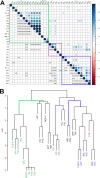Identification of Mycobacterium tuberculosis Peptides in Serum Extracellular Vesicles from Persons with Latent Tuberculosis Infection
- PMID: 32245831
- PMCID: PMC7269374
- DOI: 10.1128/JCM.00393-20
Identification of Mycobacterium tuberculosis Peptides in Serum Extracellular Vesicles from Persons with Latent Tuberculosis Infection
Abstract
Identification of biomarkers for latent Mycobacterium tuberculosis infection and risk of progression to tuberculosis (TB) disease are needed to better identify individuals to target for preventive therapy, predict disease risk, and potentially predict preventive therapy efficacy. Our group developed multiple reaction monitoring mass spectrometry (MRM-MS) assays that detected M. tuberculosis peptides in serum extracellular vesicles from TB patients. We subsequently optimized this MRM-MS assay to selectively identify 40 M. tuberculosis peptides from 19 proteins that most commonly copurify with serum vesicles of patients with TB. Here, we used this technology to evaluate if M. tuberculosis peptides can also be detected in individuals with latent TB infection (LTBI). Serum extracellular vesicles from 74 individuals presumed to have latent M. tuberculosis infection (LTBI) based on close contact with a household member with TB or a recent tuberculin skin test (TST) conversion were included in this study. Twenty-nine samples from individuals with no evidence of TB infection by TST and no known exposure to TB were used as controls to establish a threshold to account for nonspecific/background signal. We identified at least one of the 40 M. tuberculosis peptides in 70 (95%) individuals with LTBI. A single peptide from the glutamine synthetase (GlnA1) enzyme was identified in 61/74 (82%) individuals with LTBI, suggesting peptides from M. tuberculosis proteins involved in nitrogen metabolism might be candidates for pathogen-specific biomarkers for detection of LTBI. The detection of M. tuberculosis peptides in serum extracellular vesicles from persons with LTBI represents a potential advance in the diagnosis of LTBI.
Keywords: LTBI; MRM-MS; biomarker; tuberculosis.
Copyright © 2020 Mehaffy et al.
Figures



Similar articles
-
Mycobacterium tuberculosis thymidylate kinase antigen assays for designating incipient, high-risk latent M.tb infection.BMC Infect Dis. 2018 Mar 16;18(1):133. doi: 10.1186/s12879-018-3007-y. BMC Infect Dis. 2018. PMID: 29548281 Free PMC article.
-
Tuberculin skin testing compared with T-cell responses to Mycobacterium tuberculosis-specific and nonspecific antigens for detection of latent infection in persons with recent tuberculosis contact.Clin Diagn Lab Immunol. 2001 Nov;8(6):1089-96. doi: 10.1128/CDLI.8.6.1089-1096.2001. Clin Diagn Lab Immunol. 2001. PMID: 11687445 Free PMC article.
-
Diagnosis for Latent Tuberculosis Infection: New Alternatives.Front Immunol. 2020 Sep 10;11:2006. doi: 10.3389/fimmu.2020.02006. eCollection 2020. Front Immunol. 2020. PMID: 33013856 Free PMC article. Review.
-
The diagnosis of latent tuberculosis infection (LTBI): currently available tests, future developments, and perspectives to eliminate tuberculosis (TB).Med Lav. 2020 Jun 26;111(3):170-183. doi: 10.23749/mdl.v111i3.9983. Med Lav. 2020. PMID: 32624559 Free PMC article. Review.
-
Advancing new diagnostic tests for latent tuberculosis infection due to multidrug-resistant strains of Mycobacterium tuberculosis - End of the road?Int J Infect Dis. 2020 Mar;92S:S69-S71. doi: 10.1016/j.ijid.2020.02.011. Epub 2020 Feb 28. Int J Infect Dis. 2020. PMID: 32119979
Cited by
-
Tuberculosis Patients' Serum Extracellular Vesicles Induce Relevant Immune Responses for Initial Defense Against BCG in Mice.Microorganisms. 2025 Jun 29;13(7):1524. doi: 10.3390/microorganisms13071524. Microorganisms. 2025. PMID: 40732033 Free PMC article.
-
Emerging Role of Exosomes in Tuberculosis: From Immunity Regulations to Vaccine and Immunotherapy.Front Immunol. 2021 Apr 1;12:628973. doi: 10.3389/fimmu.2021.628973. eCollection 2021. Front Immunol. 2021. PMID: 33868247 Free PMC article. Review.
-
The uncharted territory of host-pathogen interaction in tuberculosis.Front Immunol. 2024 Jan 19;15:1339467. doi: 10.3389/fimmu.2024.1339467. eCollection 2024. Front Immunol. 2024. PMID: 38312835 Free PMC article. Review.
-
Does our Mycobacteriome Influence COVID-19 Morbidity and Lethality?Front Microbiol. 2021 Feb 4;12:589165. doi: 10.3389/fmicb.2021.589165. eCollection 2021. Front Microbiol. 2021. PMID: 33613475 Free PMC article. No abstract available.
-
Extracellular vesicles in bacterial and fungal diseases - Pathogenesis to diagnostic biomarkers.Virulence. 2023 Dec;14(1):2180934. doi: 10.1080/21505594.2023.2180934. Virulence. 2023. PMID: 36794396 Free PMC article. Review.
References
-
- World Health Organization. 2018. Global tuberculosis report 2018. World Health Organization, Geneva, Switzerland. https://apps.who.int/iris/bitstream/handle/10665/274453/9789241565646-en....
-
- Sterling TR, Scott NA, Miro JM, Calvet G, La Rosa A, Infante R, Chen MP, Benator DA, Gordin F, Benson CA, Chaisson RE, Villarino ME, Tuberculosis Trials Consortium the Aids Clinical Trials Group. 2016. Three months of weekly rifapentine and isoniazid for treatment of Mycobacterium tuberculosis infection in HIV-coinfected persons. AIDS 30:1607–1615. doi:10.1097/QAD.0000000000001098. - DOI - PMC - PubMed
-
- Sterling TR, Villarino ME, Borisov AS, Shang N, Gordin F, Bliven-Sizemore E, Hackman J, Hamilton CD, Menzies D, Kerrigan A, Weis SE, Weiner M, Wing D, Conde MB, Bozeman L, Horsburgh CR Jr., Chaisson RE, Tuberculosis Trials Consortium PREVENT TB Study Team. 2011. Three months of rifapentine and isoniazid for latent tuberculosis infection. N Engl J Med 365:2155–2166. doi:10.1056/NEJMoa1104875. - DOI - PubMed
MeSH terms
Substances
LinkOut - more resources
Full Text Sources
Miscellaneous

